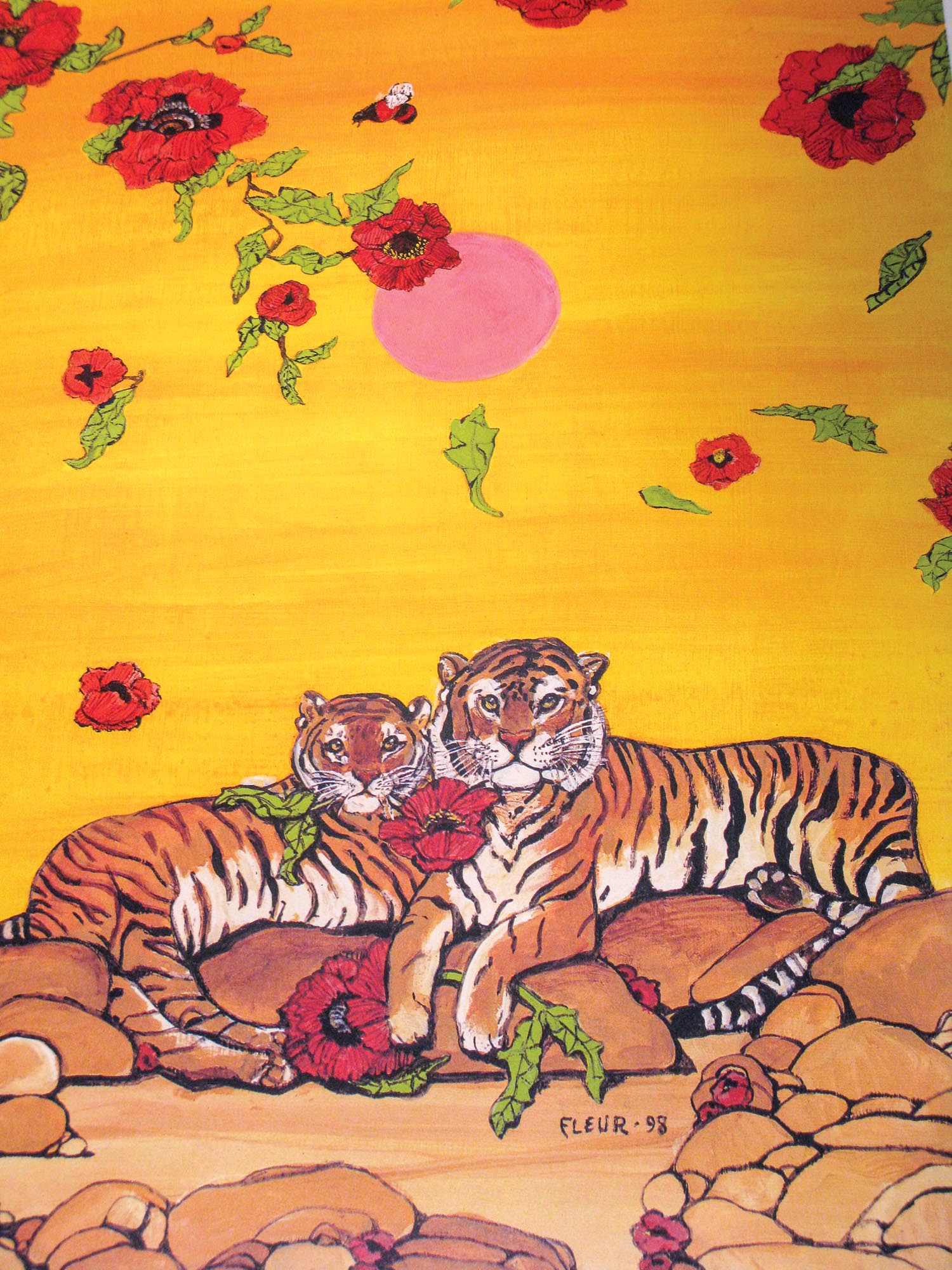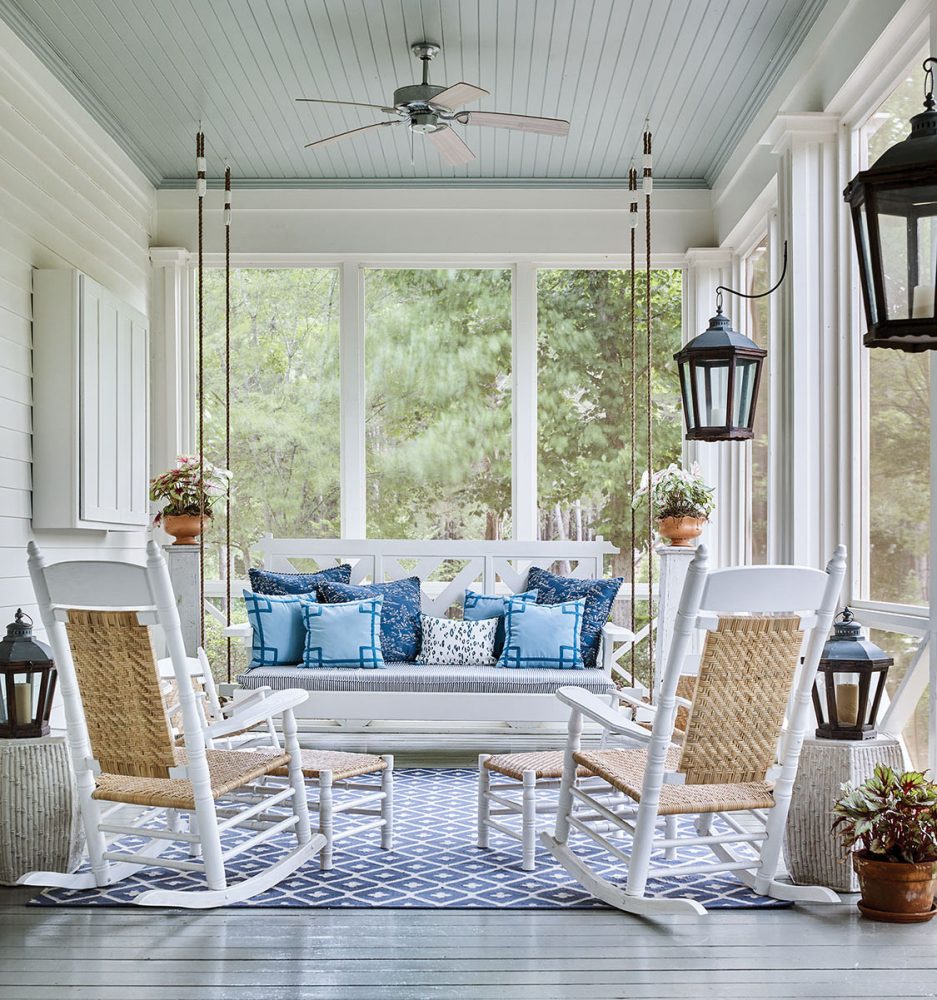
Photo courtesy of Charlotte Moss
Surrounded by examples of her own art, Fleur Cowles stands in front of the Pallavicini panels painted on hessian.
Most people best remember Fleur Cowles as the creator of one of the most innovative— and financially extravagant—magazines ever published. Flair, which launched in 1950 and lasted only one year, featured editorial contributions from esteemed individuals such as Winston Churchill, Pablo Picasso, Salvador Dali, and Jean Cocteau. Boasting covers with artistic cutouts, along with varying paper stocks for its special foldout features, the magazine was a visual feast. Its intent was to spark the intellect in a way that no other publication ever had. Flair cost $2.50 per issue to produce, yet it sold for only 50 cents on the newsstand. A financial disaster with a short lifespan, the publication remained one of Cowles’s proudest achievements.
I first met Cowles in 2005 at her Albany apartment in London. At the time, she was 97 and sharp as a tack, known for making such pronouncements as “I wake up expecting things” or “Guests have to be worth listening to.” I remember anxiously awaiting my meeting with this dynamo as I stared at the tall panels on her wall, painted by Federico Pallavicini who also worked for her at Flair. The nine panels depicted large urns with a single type of blossom in each that stretched from floor to ceiling behind a pink banquette. On one side of the panels was a tall floor vase with ceiling-height stems of dried hogweed. While I did not ask how she acquired the stems, I imagined Cowles instructing her husband to stop the car so she could hop out and cut the towering branches to take home. A city girl with a soft spot for foraging.

Photo courtesy of Charlotte Moss
Cowles’s study at Albany was filled with mementos, photos, and books. The Fleur Cowles Archive was later donated to the Harry Ransom Center at The University of Texas at Austin.
Cowles had a fearless and original style of entertaining, which featured all manner of unusual plants and vessels in a range of floral styles that always delighted guests. An abundance of flowers was usually displayed against her Wedgwood-blue walls, along with huge arrangements of dried specimens. She adored the wildness of weeds in nature and bristled at the conventions of “good-taste” flower arranging, such as the principle that flowers must have enough space between them for a butterfly to pass or that baby’s breath must never be used in combination with roses. To Cowles, such snobbery bred conformity and inhibited the freedom to play, which was a hallmark of her style—and of the style she encouraged in others. One suspects that she might have terrorized the garden club hierarchy.

Photo courtesy of Charlotte Moss
The May 1950 issue of Flair featured a characteristic cutout on the cover that depicted Cowles’s favorite flower, the rose.
There was one traditional flower, however, that Cowles adored— the rose. In fact, she dedicated an entire issue of Flair to the blooms, and she often painted them in her naive, bright, and singular style. She especially loved mixing red roses with pink clover, the weed often found growing in lawns. Her arrangements could be incredibly modern, almost abstract in design, or naturalistically abundant and loose as the occasion or location demanded. And her centerpieces often had a sly sense of humor displayed in unique combinations such as broccoli with chrysanthemums. Cowles thought flowers were best “accommodated, not arranged” in a vase or cachepot, very much in the spirit of Constance Spry. In another of her delightful turns of phrase, she stated that she liked wildflowers “plunked as picked” so that they retained their innocent charms.

Photo courtesy of Charlotte Moss
Cowles described her style of painting as “magical realism.
Cowles’s open-minded approach even extended to the vessels. While she loved Venetian glass and fine ormolu, she saw any kitchen item that had some kind of hole in it as fair game. Though she eschewed most rules, Cowles did offer a few anti-rule directives of her own: “Liberate your imagination,” “Follow your intuition;” “Don’t be inhibited,” and my favorite, “Improvise, improvise!” Among her own artistic improvisations were cheetahs and tigers floating amidst flowers in a Dali-esque manner, perhaps inspired by the 1959 biography, The Case of Salvador Dali, she wrote of her friend. Surrealistic effects aside, Cowles described her style of painting as “magical realism”—in other words, emanating from her imagination, not painted from nature.
Two years after our first encounter, Cowles and I met again. She was now 99 and mostly confined to her bedroom. Her husband, Tom Montague Meyer, brought in tea for the three of us and very carefully monitored the length of our chat to prevent tiring her. Dressed in a beautiful bed jacket, Cowles reminisced and told me about the folding screen in her room called Fête Champêtre that was painted by Marcel Vertès. As I sensed she needed rest, I told her my teenage nieces begged me to ask just one question: “What advice would you give young women today?” Without hesitation, she replied, “Select who you talk to, select what you talk about, select how long you talk…select, select, select.” I thanked her and said goodbye, knowing it was probably our last meeting. Two years later, at the age of 101, she died, leaving behind her legacy of eccentricity and creativity
By Charlotte Moss

Photo courtesy of Charlotte Moss
With a lifelong love of gardening, designer Charlotte Moss has long been intrigued with what draws people—especially women—into the world of horticulture. Some have made it their professions, while others have become enthusiasts, patrons, philanthropists, or simply weekend hobbyists. And then there are those who write about all things gardening. In her new column for FLOWER, Charlotte explores some of these women and the journeys that led to their passions for plants and flowers. She also has a forthcoming book with Rizzoli on the subject of gardening women set to release spring 2025.




